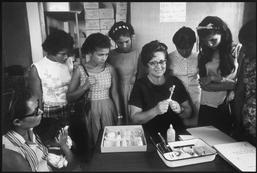
Although the pill allows American women to feel more in control of their body, many do not realize the dark history behind this method of birth control. In 1956, a researcher from Massachusetts named Gregory Pincus conducted the first experiment in Puerto Rico (specifically Rio Piedras and Humacao) to test the effectiveness of birth control. Pincus had to perform the experiment in Puerto Rico in order to avoid legal conflicts within the United States, since birth control did not become legal in America until the 1960s.
The experimenters had nearly 1,500 women try the birth control. Many of the women were poor and illiterate, but they wanted to take the pill because they wanted to plan out their families. None of the women were told about the side effects of taking this pill, and Puerto Rican doctors often were distrustful of the pill. Although at the time many were unsure about the potential side effects of the pill, Pincus was quite confident in his product and told women that they could not get pregnant as long as they took the pill regularly.
On August 2nd, 1959 Pincus wrote an article in the Washington Post detailing his observations of the experiment. He notes that at least 25 percent of women quit taking the pill because it had not been effective, causing less interest and desirability. Many participants found that the pill made them nauseous and dizzy. After these concerns were raised, in August of 1962, the FDA (Food and Drug Administration) was notified that 26 of the women endured blood clots, resulting in three deaths. Other side effects included weight gain, vomiting, headaches, stomach pain, severe cramping, constant mood changes, lack of sexual desires, and depression.
Although these women were participating in an experiment, none of them were informed that this was a trial. Since there was a major language barrier, none of them were warned about the side effects and possible risks. The experimenters only promoted a free pill and a way to prevent pregnancy. The fact that many Puerto Rican women were illiterate and lived in poverty helped the researchers select Puerto Rico as a site for the experiment.
Why was Puerto Rico chosen to be the site of these trials? In the early 1950s, Margaret Sanger, the founder of Planned Parenthood, became aware of Pincus’s creation of the pill to prevent unwanted pregnancies. Sanger was a promoter of contraception, so it is not surprising that she wanted to test the pill to see if it worked. Sanger and Pincus decided Puerto Rico would be the perfect site to do so. In 2013, Planned Parenthood claimed they went to Puerto Rico for the following reasons: Puerto Ricans accepted contraception, they were geographically close to the United States, and researchers were testing to see if illiterate women could responsibly take the pill.
Basically, what Planned Parenthood is saying is that they tricked vulnerable women into taking something that could have potentially lead to death. How are women suppose to take a pill “responsibly” if they are not even told that they are participating in an experiment, nor that there are dangerous side effects? Pincus clearly did not handle this experiment “responsibly.” Rather, the experiment was a violation of human rights.
The United States has history of racism towards Puerto Ricans and this experiment can be added to the list of human rights violations. The researchers preyed on Puerto Rican women who lived in poverty and were illiterate. They tricked them into taking a pill, not warning them about the dangerous effects. Through the suffering of these women, the researchers found out that the root of the problem was the dosages that the Puerto Ricans were taking. The women were taking very high dosages, causing them to be more prone to the side effects, so the researchers learned to lower the dosage when presenting the pill to Americans.
While Americans have been provided with proper education on the pill as a method of birth control, many of the Puerto Rican women were left suffering and some dead. Pincus and the creator of Planned Parenthood is to blame for these unjust actions. Sanger is a self-proclaimed feminist, yet she did this to other women, especially vulnerable women. Planned Parenthood is a great organization that has helped many women, but that does not justify its dark history. This organization must acknowledge its wrongdoings and apologize to the women they have hurt.
Information from:
HANNAH CLAGGETT
